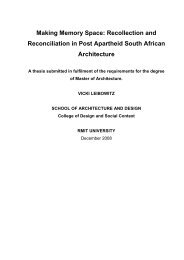Objects in Flux - RMIT Research Repository - RMIT University
Objects in Flux - RMIT Research Repository - RMIT University
Objects in Flux - RMIT Research Repository - RMIT University
Create successful ePaper yourself
Turn your PDF publications into a flip-book with our unique Google optimized e-Paper software.
<strong>Objects</strong> <strong>in</strong> <strong>Flux</strong><br />
18<br />
2005). Beyond this narrow doma<strong>in</strong> numerous recent publications have<br />
exam<strong>in</strong>ed the broad economic benefit to be ga<strong>in</strong>ed from practices<br />
of consumer production. Often cast as ‘open <strong>in</strong>novation’, consumer<br />
production has been recognised as a cost-effective alternative to commercial<br />
research and development (Chesbrough, 2006; Goldman &<br />
Gabriel, 2005; Thrift, 2006; Von Hippel, 2005). In the book Democratiz<strong>in</strong>g<br />
Innovation, Eric von Hippel cites examples of user <strong>in</strong>novation<br />
from fields as diverse as w<strong>in</strong>dsurf<strong>in</strong>g and open source software, claim<strong>in</strong>g<br />
that practices of consumer production are becom<strong>in</strong>g <strong>in</strong>creas<strong>in</strong>gly<br />
common with<strong>in</strong> contemporary society (2005).<br />
Likewise, Charles Leadbeater and Paul Miller suggest we are <strong>in</strong> the<br />
midst of a ‘pro-am revolution’ where ‘<strong>in</strong>novative, committed and<br />
networked amateurs work<strong>in</strong>g to professional standards’ are creat<strong>in</strong>g<br />
new organisational models that challenge traditional corporate and<br />
state modes of production (2004, p. 9). En-masse, consumer activity<br />
has been conceived as a swarm or cloud of productive potential that,<br />
until recently, has rema<strong>in</strong>ed largely untapped (Corney, Torres-Sanchez,<br />
Jagadeesan, & Regli, 2010; Gloor, 2006). The general consensus<br />
amongst these texts is that this new era of consumer production has<br />
been <strong>in</strong>stigated by a dramatic shift <strong>in</strong> communication technologies. In<br />
particular, the emergence of the Internet has allowed for distributed<br />
media production and knowledge shar<strong>in</strong>g on an unprecedented scale<br />
(Benkler, 2006).<br />
It is worth not<strong>in</strong>g, however, that this revolution has been a long time<br />
com<strong>in</strong>g. In the 1972 publication Adhocism Charles Jencks imag<strong>in</strong>ed<br />
a ‘resource-full computer’ that would allow for ‘decentralised design<br />
and consumption based on <strong>in</strong>dividual desire’, a comb<strong>in</strong>ation of<br />
‘Hippie consumer tactics and the space program’. Jencks states that<br />
‘With an electrified consumer democracy, the time spent and the cost<br />
of consumption would plummet, and the impersonal subsystems of<br />
large corporations would be repersonalized by comb<strong>in</strong><strong>in</strong>g them ad<br />
hoc towards specific ends’ (1972, p. 55). Jencks and Silver propose<br />
adhocism as a panacea to forces of determ<strong>in</strong>ism, specialisation and<br />
bureaucracy with<strong>in</strong> modern society that frustrate natural creativity<br />
and self-realisation (1972, p. 19). While envisag<strong>in</strong>g a new wave of<br />
‘consumer democracy’ where <strong>in</strong>dividuals actively participate <strong>in</strong> the<br />
construction of their environment, Jencks and Silver also recognised
















